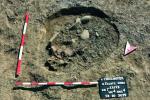Summary (English)
EXPLORATIONS NEAR THE VILLAGE OF SINEMORETS (Daniela Agre – daniela.agre@abv.bg, Deyan Dichev) In Sector South, the outer side of the southern fortification wall to the west of the tower was discovered in Trenches Z4 and I4. It was 1.40 m wide, built of roughly-cut stones. The gate of the fortification was discovered to the west of the tower; it was 2 m wide, flanked by two pilasters 1.40 m long and 1.10 m wide, built of roughly-cut stones bonded with mud. In Sector West, the drainage canal parallel to the southern fortification wall was explored, filled with sherds. In Trenches I7/Y7 the excavations of House No. 1 continued. A stratum c. 20 cm thick was discovered, containing burned fragmentary wattle-and-daub. Three bronze coins of the Thracian King Mostis (110 – 85 BC) and three small cult terracotta objects were discovered on the floor. In Trench Y8, burned fragmentary wattle-and-daub was found and the inner side of the fortification wall was excavated. In Trench Y9, sherds were found; two bronze coins of Mostis were found on the floor of House No. 2. In Trenches I12 – Y 12 Late Hellenistic finds were discovered; a layer of burned fragmentary wattle-and-daub was explored, originating from destroyed rooms that adjoined the fortification wall. In the Northeastern Sector, a pile of uneven stones, fragmentary building ceramics and burned fragmentary wattle-and-daub was excavated in Trench G15; Late Hellenistic pottery was found. In Trenches V12–13 and G12–13 five pits (Nos. 3 – 7) were discovered. Pits Nos. 4, 5 and 7 contained fragmentary wattle-and-daub, animal bones, pieces of charcoal, ceramic vessels broken in situ and sherds of the Early Bronze Age 3, while a bronze bar was also found in Pit No. 5. Pits Nos. 3 and 6 contained sherds of the 1st century BC – 1st century AD. In Sector East, a section of the eastern fortification wall was discovered in Trench B6. In Trench V6, the floor level was revealed; bronze coins of Mostis, sherds, including from Megarian bowls and amphorae, were found on the floor. In Trench B6, five Christian burials of the 19th century were excavated. The grave goods included ceramic vessels, bronze, silver and glass jewelry, small iron knives, terracotta plates with cross and inscription that reads: IC XC NIKA. The Late Hellenistic pottery from the excavations included Megarian bowls, krateroi imported from Anatolian production centers, Thracian hand-made vessels and amphorae of Kos, Rhodes and Knidos. Fifteen bronze coins were found: one of the Thracian King Sadalas (c. 90 – 58 BC), one minted in Byzantion in the beginning of the 1st century BC and 13 of Mostis. The chronology of the site is – First Period: the existence of the Thracian royal tyrsis during the last quarter of the 2nd – beginning of the 1st centuries BC and its burning; Second Period: occupation in the western part of the site during c. 75 – 50 BC and its destruction; Third Period: digging pits containing pottery of the 1st century BC – 1st century AD; Fourth Period: existence of a church with a cemetery during the 18th – 19th centuries.
- Daniela Agre - Archaeological Institute with Museum
- Deyan Dichev - Archaeological Institute with Museum
Director
- Daniela Agre - Archaeological Institute with Museum
- Deyan Dichev - Archaeological Institute with Museum
Team
Research Body
- Archaeological Institute with Museum






![Download [PDF]](/excavation/skins/fasti/images/results/download_sml.png)
